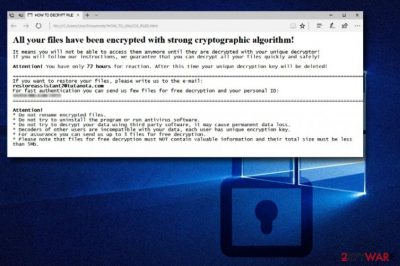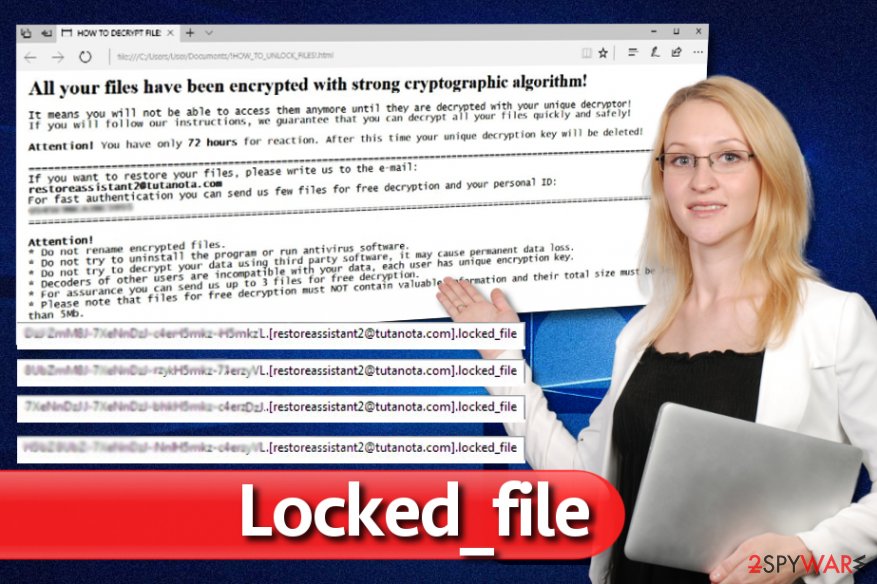Locked_file ransomware / virus (Improved Guide) - Free Guide
Locked_file virus Removal Guide
What is Locked_file ransomware virus?
The new ransomware appends .Locked_file extensions to encrypted files and demands a ransom

Locked_file ransomware is a new computer virus that targets Windows operating systems. The virus is very similar to .locked file extension virus, however, it adds a slightly modified file extension – .[restoreassistant2@tutanota.com].LOCKED_FILE. The virus aims to encrypt[1] all files as fast as possible, and afterward, it drops !HOW_TO_UNLOCK_FILES!.html file to provide a ransom-demanding message to the victim.
The Locked_file virus also modifies the original file name, replacing it with a set of random characters.
The ransom note launches via default web browser and suggests that “all files have been encrypted with strong cryptographic algorithm.” The threatening message suggests that the victim has 72 hours to contact cyber criminals via restoreassistant2@tutanota.com. The note also contains victim’s personal ID, which is used to identify each victim.
Traditionally, criminals provide a “test our decryption tool” feature and ask to send some files along with the identification code to their email address.
However, at the moment ransomware is under analysis, so it is unknown whether a free data recovery is possible. Please stay patient, because malware analysts might come up with a free .locked_file decryption tool.
To remove Locked_file virus, you will need a powerful and up-to-date anti-malware software. We suggest using FortectIntego, although you can use a security software of your choice. Before running your malware or spyware removal tool, make sure you restart your computer in Safe Mode with networking first. You can use Locked_file removal guidelines that we prepared to complete this task with ease.

Distribution of the new virus
The recently discovered ransomware doesn’t seem to be an in-development or test version of the virus, meaning that it poses a real threat to the virtual community and can get into anyone’s computer with only one condition – the computer has to be unprotected. Novirus.uk[2] experts share these tips that can help you to protect yourself against a ransomware attack:
- To prevent ransomware attacks, we suggest installing a good security product and creating a data backup[3]. These are essential steps to take towards better computer security.
- In addition, we strongly recommend staying away from questionable emails you might receive in your email account. If you noticed a suspicious letter from someone who wasn’t supposed to contact you – be it a well-known company or a suspicious stranger, do not open file attachments or links included in the email. These might appear to be straight paths to a complete data loss.
- Finally, keep your programs up-to-date. It means that you should always use the latest versions of software so that cyber criminals couldn’t exploit vulnerabilities in them.
Remove Locked_file ransomware
If you want to continue using your computer, it is a must to remove Locked_file virus now. To entirely eliminate the malware, you must use a professional anti-malware software. Technically, it is possible to delete the virus manually, but you need to have outstanding computing skills to detect and eliminate them all.
Therefore, we strongly suggest choosing a reliable software to perform an automatic Locked_file removal for your.
Getting rid of Locked_file virus. Follow these steps
Manual removal using Safe Mode
Delete Locked_file virus professionally. Restart the computer using the guidelines given below and run it in Safe Mode with Networking as explained below.
Important! →
Manual removal guide might be too complicated for regular computer users. It requires advanced IT knowledge to be performed correctly (if vital system files are removed or damaged, it might result in full Windows compromise), and it also might take hours to complete. Therefore, we highly advise using the automatic method provided above instead.
Step 1. Access Safe Mode with Networking
Manual malware removal should be best performed in the Safe Mode environment.
Windows 7 / Vista / XP
- Click Start > Shutdown > Restart > OK.
- When your computer becomes active, start pressing F8 button (if that does not work, try F2, F12, Del, etc. – it all depends on your motherboard model) multiple times until you see the Advanced Boot Options window.
- Select Safe Mode with Networking from the list.

Windows 10 / Windows 8
- Right-click on Start button and select Settings.

- Scroll down to pick Update & Security.

- On the left side of the window, pick Recovery.
- Now scroll down to find Advanced Startup section.
- Click Restart now.

- Select Troubleshoot.

- Go to Advanced options.

- Select Startup Settings.

- Press Restart.
- Now press 5 or click 5) Enable Safe Mode with Networking.

Step 2. Shut down suspicious processes
Windows Task Manager is a useful tool that shows all the processes running in the background. If malware is running a process, you need to shut it down:
- Press Ctrl + Shift + Esc on your keyboard to open Windows Task Manager.
- Click on More details.

- Scroll down to Background processes section, and look for anything suspicious.
- Right-click and select Open file location.

- Go back to the process, right-click and pick End Task.

- Delete the contents of the malicious folder.
Step 3. Check program Startup
- Press Ctrl + Shift + Esc on your keyboard to open Windows Task Manager.
- Go to Startup tab.
- Right-click on the suspicious program and pick Disable.

Step 4. Delete virus files
Malware-related files can be found in various places within your computer. Here are instructions that could help you find them:
- Type in Disk Cleanup in Windows search and press Enter.

- Select the drive you want to clean (C: is your main drive by default and is likely to be the one that has malicious files in).
- Scroll through the Files to delete list and select the following:
Temporary Internet Files
Downloads
Recycle Bin
Temporary files - Pick Clean up system files.

- You can also look for other malicious files hidden in the following folders (type these entries in Windows Search and press Enter):
%AppData%
%LocalAppData%
%ProgramData%
%WinDir%
After you are finished, reboot the PC in normal mode.
Remove Locked_file using System Restore
-
Step 1: Reboot your computer to Safe Mode with Command Prompt
Windows 7 / Vista / XP- Click Start → Shutdown → Restart → OK.
- When your computer becomes active, start pressing F8 multiple times until you see the Advanced Boot Options window.
-
Select Command Prompt from the list

Windows 10 / Windows 8- Press the Power button at the Windows login screen. Now press and hold Shift, which is on your keyboard, and click Restart..
- Now select Troubleshoot → Advanced options → Startup Settings and finally press Restart.
-
Once your computer becomes active, select Enable Safe Mode with Command Prompt in Startup Settings window.

-
Step 2: Restore your system files and settings
-
Once the Command Prompt window shows up, enter cd restore and click Enter.

-
Now type rstrui.exe and press Enter again..

-
When a new window shows up, click Next and select your restore point that is prior the infiltration of Locked_file. After doing that, click Next.


-
Now click Yes to start system restore.

-
Once the Command Prompt window shows up, enter cd restore and click Enter.
Bonus: Recover your data
Guide which is presented above is supposed to help you remove Locked_file from your computer. To recover your encrypted files, we recommend using a detailed guide prepared by 2-spyware.com security experts.To recover your files, use the most recent data backup that you have. If you do not have any data copies, try one of the following data recovery techniques:
If your files are encrypted by Locked_file, you can use several methods to restore them:
Test Data Recovery Pro
Although there is no guarantee that this tool will restore all of your files, you can test it and see whether Data Recovery Pro can recover some of the encrypted files. Here is how to use this software.
- Download Data Recovery Pro;
- Follow the steps of Data Recovery Setup and install the program on your computer;
- Launch it and scan your computer for files encrypted by Locked_file ransomware;
- Restore them.
Shadow Copies can save you
Sometimes ransomware viruses fail to delete Volume Shadow Copies which are essential when trying to recover lost data. ShadowExplorer software can help you to restore your files for free (in case Locked_file malware failed to delete VSS).
- Download Shadow Explorer (http://shadowexplorer.com/);
- Follow a Shadow Explorer Setup Wizard and install this application on your computer;
- Launch the program and go through the drop down menu on the top left corner to select the disk of your encrypted data. Check what folders are there;
- Right-click on the folder you want to restore and select “Export”. You can also select where you want it to be stored.
Finally, you should always think about the protection of crypto-ransomwares. In order to protect your computer from Locked_file and other ransomwares, use a reputable anti-spyware, such as FortectIntego, SpyHunter 5Combo Cleaner or Malwarebytes
How to prevent from getting ransomware
Protect your privacy – employ a VPN
There are several ways how to make your online time more private – you can access an incognito tab. However, there is no secret that even in this mode, you are tracked for advertising purposes. There is a way to add an extra layer of protection and create a completely anonymous web browsing practice with the help of Private Internet Access VPN. This software reroutes traffic through different servers, thus leaving your IP address and geolocation in disguise. Besides, it is based on a strict no-log policy, meaning that no data will be recorded, leaked, and available for both first and third parties. The combination of a secure web browser and Private Internet Access VPN will let you browse the Internet without a feeling of being spied or targeted by criminals.
No backups? No problem. Use a data recovery tool
If you wonder how data loss can occur, you should not look any further for answers – human errors, malware attacks, hardware failures, power cuts, natural disasters, or even simple negligence. In some cases, lost files are extremely important, and many straight out panic when such an unfortunate course of events happen. Due to this, you should always ensure that you prepare proper data backups on a regular basis.
If you were caught by surprise and did not have any backups to restore your files from, not everything is lost. Data Recovery Pro is one of the leading file recovery solutions you can find on the market – it is likely to restore even lost emails or data located on an external device.





















